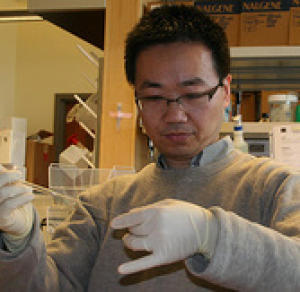
该项目的主要研究人员Pin Wang教授(图)
在治疗艾滋病的道路上人类又迈出了重要的一步,美国南加州大学的科学家们研发了一种慢病毒可以杀死被艾滋病毒所感染的细胞。
这项研究的论文发表在最新一期的《Virus Research》杂志上,美国南加州大学的化学工程学教授Pin Wang博士的慢病毒载体能锁定被艾滋病毒所感染的细胞,先通过一种称为“自杀基因疗法”的途径损伤它们,然后使用药物靶向杀死这些被感染的细胞。
Wang博士说道:“如果你能清除体内所有被艾滋病毒感染的细胞,你至少能解决一部分的问题。”
这个过程类似于军事行动中的“激光制导”(意思是一个地面的士兵通过激光指示目标,以实现精确空袭),这个慢病毒载体能够在靶向艾滋病毒的同时又避免对正常细胞造成任何其它损伤,并以无害的方式保护细胞不受艾滋病毒的感染。“如果是仅仅通过药物,无法做到杀死被艾滋病毒感染的细胞同时又保证正常的细胞不受损害。”Wang博士说道。
目前的研究结果显示,这种慢病毒载体在培养皿中能杀死大约35%的被艾滋病毒感染的细胞,这似乎听起来不是一个很高的效率,但如果将其用在人体上,使用的量将会翻数倍以达到最大的效果。
Wang博士说道:“下一步的实验将在小鼠身上进行,虽然实验还处于早期阶段,但我们有理由相信这可能会是未来治疗艾滋病的有效手段。” (生物探索 Jun译)
生物探索推荐英文论文原文摘要:
Engineered lentiviral vectors pseudotyped with a CD4 receptor and a fusogenic protein can target cells expressing HIV-1 envelope proteins
Lentiviral vectors (LVs) derived from human immunodeficiency virus type 1 (HIV-1) are promising vehicles for gene delivery because they not only efficiently transduce both dividing and non-dividing cells, but also maintain long-term transgene expression. Development of an LV system capable of transducing cells in a cell type-specific manner can be beneficial for certain applications that rely on targeted gene delivery. Previously it was shown that an inverse fusion strategy that incorporated an HIV-1 receptor (CD4) and its co-receptor (CXCR4 or CCR5) onto vector surfaces could confer to LVs the ability to selectively deliver genes to HIV-1 envelope-expressing cells. To build upon this work, we aim to improve its relatively low transduction efficiency and circumvent its inability to target multiple tropisms of HIV-1 by a single vector. We investigated a method to create LVs co-enveloped with the HIV-1 cellular receptor CD4 and a fusogenic protein derived from the Sindbis virus glycoprotein and tested its efficiency to selectively deliver genes into cells expressing HIV-1 envelope proteins. The engineered LV system yields a higher level of transduction efficiency and a broader tropism towards cells displaying the HIV-1 envelope protein (Env) than the previously developed system. Furthermore, we demonstrated in vitro that this engineered LV can preferentially deliver suicide gene therapy to HIV-1 envelope-expressing cells. We conclude that it is potentially feasible to target LVs towards HIV-1-infected cells by functional co-incorporation of the CD4 and fusogenic proteins, and provide preliminary evidence for further investigation on a potential alternative treatment for eradicating HIV-1-infected cells that produce drug-resistant viruses after highly active antiretroviral therapy (HAART).







